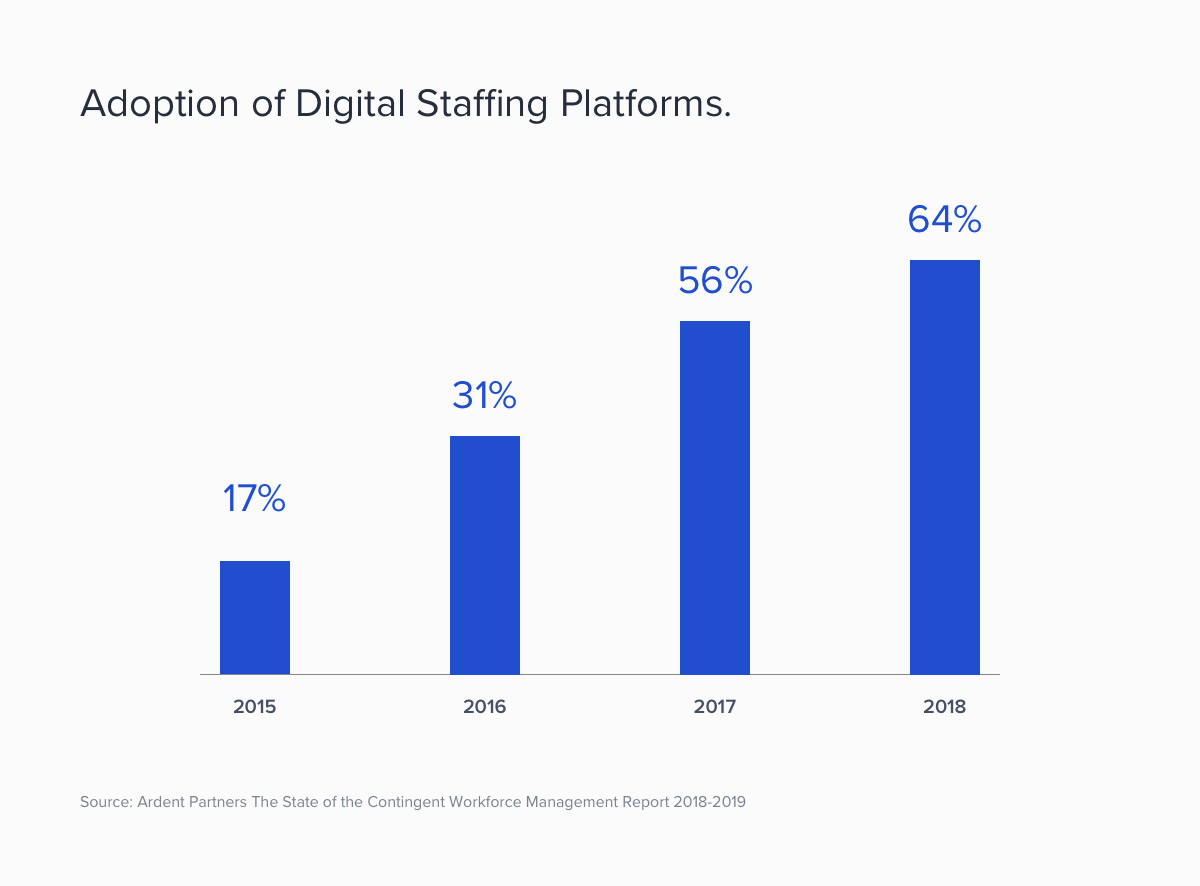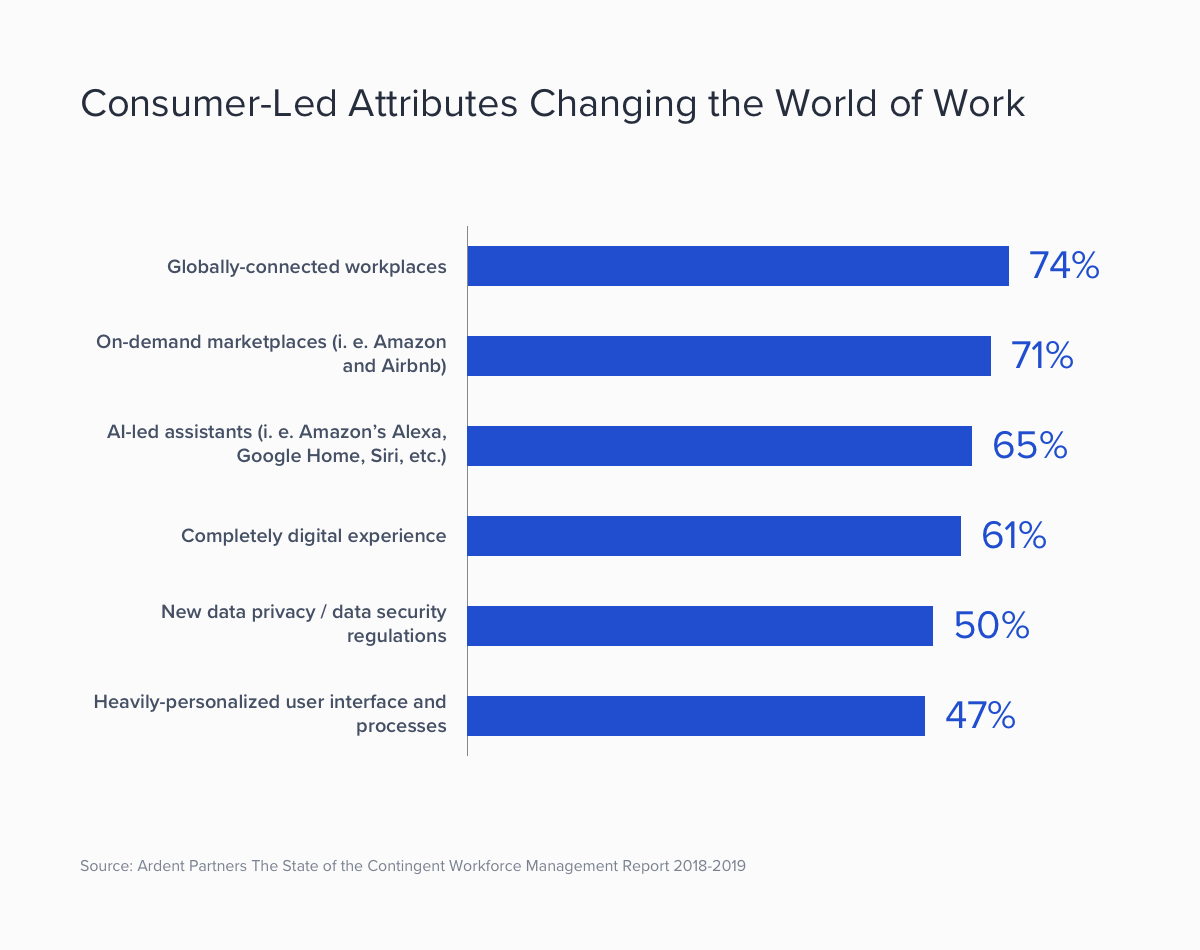Why 2020 Will Be a Tipping Point for Digital Staffing
authors are vetted experts in their fields and write on topics in which they are extremely knowledgeable. All of our content is peer reviewed and validated by world-class professionals.

As recently as five years ago, only 25% (or less) of all non-employee talent was sourced via progressive talent engagement solutions, such as on-demand and digital staffing platforms, according to Ardent research. The vast majority of talent across the globe was engaged and acquired via traditional means, such as staffing suppliers and conventional recruitment models. Even though the world’s total talent marketplace was beginning to experience a shift toward more flexible, project-based work (the number of self-employed people is expected to reach 42 million next year), the realm of digital staffing technology was just beginning its ascent into the worlds of talent and work.
Ardent Partners’ latest research has discovered that the utilization of on-demand and digital staffing technology has increased nearly 300% over the past three years, a surefire representation of the continued shifts in how businesses ultimately source the talent they need. Digital staffing platforms are gaining traction because they allow companies to source highly skilled talent while maintaining control of the process. Here’s why 2020 will be a tipping point for this industry:

The Talent Market Is Crowded
Call it a by-product of the so-called “gig economy”: Today, more than ever before, professionals are presented with opportunities to transform the way they personally perceive “work.” A 2018 report by BCG and Harvard Business School outlined four categories, including digital nomads, fly-in experts (such as an on-site, temporary consultant or manager), autonomous click workers (for example, finding work on a crowdsourcing platform), and digital valets (for example, an Uber driver).
Increasingly, talented individuals are leveraging on-demand and digital staffing networks to connect with prospective employers. It’s not because they need to in order to find employment; it’s because they prefer freelance and on-demand work. According to the same BCG-Harvard Business School report, freelancers prefer independent work to salaried, full-time work by more than 2:1. The report cites the fact that freelance work offers more interesting projects and a greater home/work-life balance, leading to higher happiness and satisfaction levels than colleagues who are employed full-time. As consumer trends continue to impact the future of work – including the speed of expectations and the pursuit of interests outside of work – we can expect talent to continue to use digital platforms to find work.

Platform Value Propositions Are Becoming Clear
Digital staffing platforms are designed for customer ease of use, which can lead to businesses spending less time selecting a staffing platform than they would a VMS or ERP platform. However, as these tools become a bigger piece of the workforce management technology ecosystem, businesses will need to execute deeper due diligence to understand which solutions are best aligned with their overall talent engagement and acquisition requirements.
These platforms simplify and streamline the talent acquisition process by providing an eCommerce-like experience to find the best talent for a specific project. Some platforms specialize in curating talent for specific verticals or geographies, such as Trusted Health for nurses and Twago for matching companies and talent in Europe. Similar to VMS and HRIS, digital talent platforms also offer an enterprise-level solution that can include analytics, talent gap identification, and project management capabilities.
Ardent’s Digital Staffing Technology Advisor report found that across the 11 major enterprise solutions assessed in the study (Adpeto, Crowdstaffing, Field Nation, Genesys Talent, Kalo, Shiftgig, Shortlist, TalentNet, Talon FMS, and Toptal), these solutions are enabling a wide range of “larger-scale” workforce management functionality, such as workforce planning and the ability to develop role-specific or skillset-specific pools of known talent.
Digital Staffing Technology Is Foundational to the “Agile Workforce”
The concept of the “agile workforce,” then, follows the natural evolution of the non-employee workforce to account for major shifts happening in the worlds of talent acquisition and staffing. According to Deloitte’s 2019 Human Capital Trends report, 41% of respondents consider the alternative workforce important, but only 28% say they’re ready for it. BCG and Harvard Business School’s survey reports 40% of companies expected an increased percent of their workforce to be alternative in the next five years, and 50% said adoption of “gig” platforms would be a significant trend.
According to Ardent research:
- 81% of businesses today cite “agility” as their top desired state, a bigger challenge than driving cost savings, improving visibility, and enhancing compliance (all of which, of course, remain critical to the modern organization).
- Nearly 70% of businesses cite on-demand sources of talent such as digital staffing platforms and online talent marketplaces as a major catalyst in how work is done.
- Investments in new technology and innovative platforms are the top priority (83%) for organizations as they look ahead to their contingent workforce programs.
- Mastering the many channels of talent acquisition (63%) is a high-level priority for businesses.
- 66% of organizations plan to have an integrated talent acquisition strategy in place within the next two years, foundational for agility and providing the best possible match between project and talent.
Digital staffing is the enabler for attracting and retaining the agile workforce and will become even more critical in 2020 and beyond. Businesses increasingly are embracing the power of technology to automate talent pool curation, connect hiring managers with the best-aligned talent for a given project or role, and help key HR, procurement, and talent acquisition stakeholders understand the very makeup of their total workforce.
